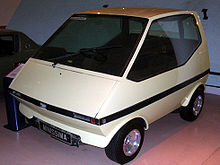- Minissima
-
The Minissima is a small concept city car that was designed by William Towns (as the Townscar) as his idea for a replacement for the Mini in 1972 and displayed by BLMC on their stand at the 1973 London Motor Show after buying the prototype from Towns.[1]
In common with the Mini it was designed around 10" wheels and the BMC A-Series engine. It is 30" (75 cm) shorter than the Mini and designed to park end-on to the curb (like the Smart Fortwo), having only one door - at the rear. It has four seats, two at the front, front facing, and two facing inwards at the rear.[2]
The Minissina design re-emerged a few years later as a prototype car for the disabled, adapted by engineering firm GKN Sankey by ex Ford engineer Fred Hart.[3] During the engineering process, the layout changed to feature a central driving position in which a wheelchair user would enter through the back door using a fold-down rear ramp, and drive off. The styling was simplified by William Towns to suit mass production and won a Design Council award in 1978,[4] it did not gain government support due to high costs and the project was cancelled.
References
- ^ Motor 1985 volume 167
- ^ Adams, Keith. "Minissima". The Unofficial Austin-Rover Web. http://www.austin-rover.co.uk/index.htm?ado15minissf.htm. Retrieved March 8, 2006.
- ^ Telegraph 16 July 2008
- ^ The Engineer 1979 volume 248]
- An article about the car written by British motoring journalist, Paul Walton, was printed in the August 2008 edition of Classic & Sportscar magazine
Categories:- Concept automobiles
Wikimedia Foundation. 2010.

